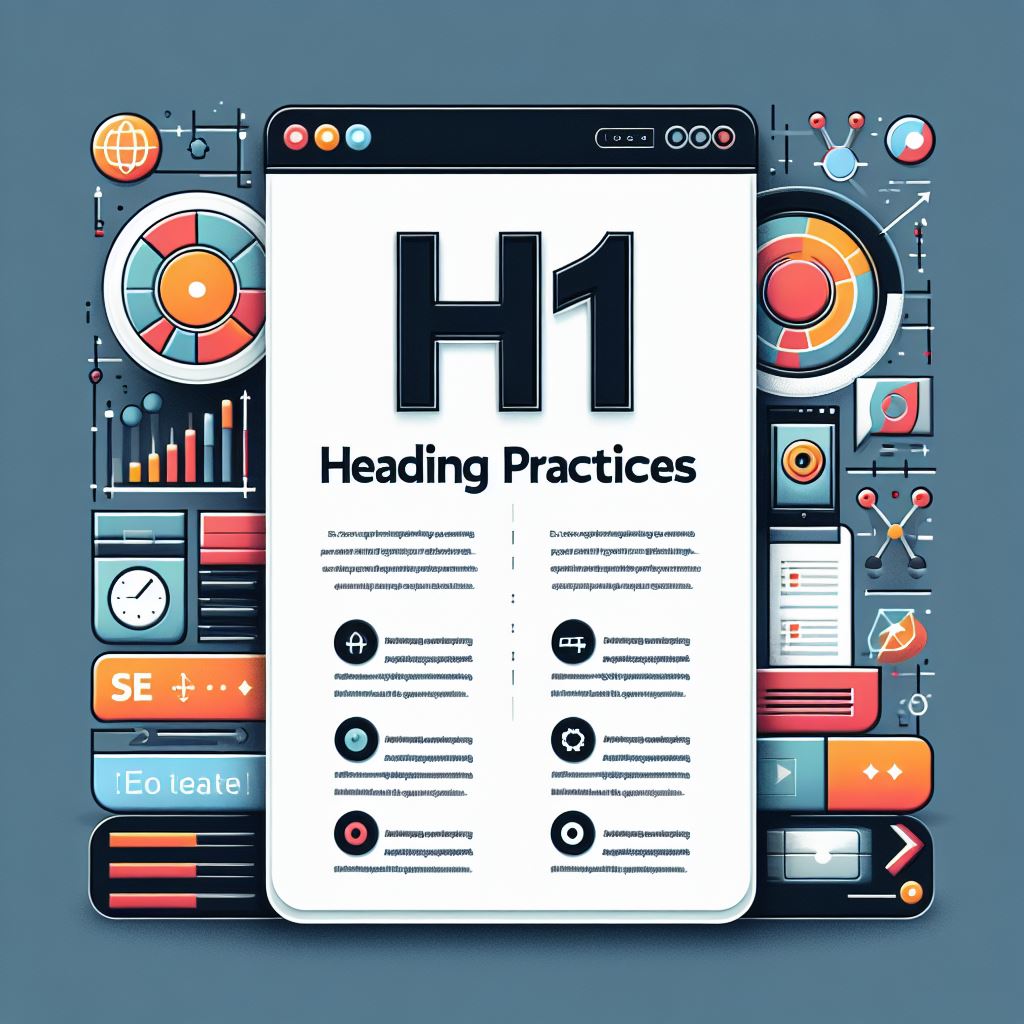
What is H1 or Heading Structure 1 ?
In SEO (Search Engine Optimization), H1 refers to the HTML tag used to denote the main heading or title of a webpage. The “H” stands for “Heading,” and the “1” indicates that it’s the highest level of heading, conveying the most importance in terms of content hierarchy. Here’s a detailed explanation of what H1 tags are in SEO:
- HTML Structure: H1 tags are part of the HTML (Hypertext Markup Language) markup language, which is used to structure and format content on webpages. They are enclosed within
<h1> and </h1> tags, with the main heading text placed between them. For example:
<h1>Main Heading</h1>
- Semantic Meaning: H1 tags provide semantic meaning to the content within them, indicating to both search engines and website visitors that the enclosed text is the most important heading on the page. Search engines rely on HTML markup to understand the structure and context of webpages, and H1 tags help them identify the main topic or theme of a page.
- Content Organization: By using H1 tags appropriately, website owners can organize their content in a logical and hierarchical manner. H1 tags typically represent the main title or headline of a webpage, summarizing its primary focus or purpose. This helps visitors quickly grasp the essence of the page’s content and navigate the site more efficiently.
- SEO Impact: Proper use of H1 tags is important for SEO because search engines consider them when determining the relevance and ranking of a webpage for specific search queries. Including relevant keywords in H1 tags can signal to search engines what the page is about and improve its chances of appearing in relevant search results. However, it’s essential to use keywords naturally and ensure that the H1 tag accurately reflects the content of the page.
- User Experience: In addition to their SEO benefits, H1 tags contribute to a better user experience by providing clear headings that help visitors understand the structure and organization of a webpage. Well-structured headings, including a prominently displayed H1 tag, make it easier for users to scan content, find what they’re looking for, and engage with the site’s content more effectively.
- Accessibility: Properly using H1 tags also enhances accessibility for users who rely on screen readers or other assistive technologies to navigate the web. Screen readers typically use heading tags to navigate and understand the structure of a webpage, so using H1 tags correctly ensures that all users can access and comprehend the content effectively.
H1 tags are a fundamental component of SEO and web design, providing semantic meaning, organizing content, improving user experience, and enhancing accessibility. By using H1 tags appropriately and incorporating relevant keywords, website owners can optimize their webpages for better visibility and rankings in search engine results.

Importance of Heading Structure 1 or H1 Tag In SEO.
In SEO (Search Engine Optimization), H1 (Heading 1) tags play a crucial role in helping search engines understand the structure and content of a web page. Here’s a detailed explanation of the importance of H1 tags in SEO:
- Semantic Structure: H1 tags provide semantic meaning to the content of a webpage. Search engines use these tags to understand the main topic or theme of the page. It’s like telling search engines, “This is the most important headline on this page.” Properly structuring your content with H1 tags helps search engines index and rank your page more accurately.
- User Experience (UX): H1 tags not only benefit search engines but also improve the user experience. They act as a visual cue for users, guiding them to the main topic or headline of the page. Well-structured headings make it easier for visitors to scan through the content and find what they’re looking for, thus enhancing user engagement and reducing bounce rates.
- Keyword Optimization: Incorporating relevant keywords into your H1 tags can positively impact your SEO efforts. Search engines give weight to keywords within H1 tags when determining the relevance of a page to a particular search query. However, it’s important to ensure that your H1 tags accurately reflect the content of the page and provide value to users, rather than stuffing them with keywords.
- Accessibility: Properly using H1 tags enhances accessibility for users who rely on screen readers or other assistive technologies. Screen readers often navigate web pages by scanning headings, so having descriptive and properly structured H1 tags ensures that all users can easily understand the content hierarchy of a page.
- Indexing and Ranking: Search engines use various factors to determine the relevance and authority of a webpage for specific search queries. Well-optimized H1 tags contribute to these factors by providing clear signals about the main topic of the page. When search engines crawl and index your site, they use H1 tags to understand the context and relevance of your content, which can ultimately impact your ranking in search engine results pages (SERPs).
- Content Organization: Using H1 tags helps organize your content into logical sections, making it easier for both search engines and users to understand the structure of your page. This can also indirectly impact SEO by encouraging longer dwell times and reducing bounce rates, as users are more likely to stay on a well-structured page that is easy to navigate and comprehend.
H1 tags are essential for SEO because they provide semantic meaning to your content, improve user experience, help with keyword optimization, enhance accessibility, and contribute to better indexing and ranking by search engines. Properly optimizing your H1 tags can significantly impact the visibility and performance of your web pages in search results.
What are the Use Cases for H1 Tag or Heading Structure 1 for Better SEO ?
Using H1 tags effectively can significantly contribute to better SEO by providing clarity to search engines about the main topic or theme of your webpage. Here’s a detailed explanation of where and how to use H1 tags for better SEO:
- Title/Header: The primary and most common use of the H1 tag is for the title or header of your webpage. This is typically the main headline or the most important text on the page. It should accurately summarize the content of the page and include relevant keywords that users might search for. Placing your main title/header within an H1 tag gives it semantic importance, signaling to search engines that this is the key topic of the page.
- Blog Post Titles: For blog posts or articles, using H1 tags for the title of each individual post is crucial. Each blog post should have a unique and descriptive title that reflects the content of the post and includes relevant keywords. By enclosing the post title in an H1 tag, you’re emphasizing its importance to both users and search engines, which can improve its visibility in search results.
- Section Headings: Within the content of your webpage or blog post, you can use H1 tags for section headings to break up the text and provide structure. These section headings should outline the different topics or subtopics covered in your content. By using H1 tags for section headings, you’re helping search engines understand the hierarchy and organization of your content, which can improve indexing and ranking.
- Product or Service Names: If you’re running an e-commerce website or a site that showcases various products or services, using H1 tags for the names of your products or services can be beneficial. This not only helps with SEO but also improves the user experience by highlighting the key offerings of your site. Ensure that each product or service name is unique and descriptive, including relevant keywords where appropriate.
- Main Call-to-Action (CTA): In some cases, the main call-to-action on your webpage could be emphasized using an H1 tag. For example, if your goal is to drive visitors to sign up for a newsletter or make a purchase, you might use an H1 tag for the headline that encourages users to take that action. This helps prioritize the most important element on the page and can improve conversion rates.
- Homepage Headline: On your website’s homepage, the main headline or value proposition can be enclosed in an H1 tag to emphasize its significance. This headline should succinctly convey what your website is about and what value it offers to visitors. By using an H1 tag for the homepage headline, you’re signaling to search engines that this is the main focus of your website.
- FAQs or Q&A Pages: If you have a frequently asked questions (FAQs) page or a Q&A section on your website, using H1 tags for the questions or topics can help improve SEO. Each question can be enclosed in an H1 tag, making it easier for search engines to identify the different topics covered on the page and potentially improve visibility for relevant search queries.
In conclusion, using H1 tags in strategic locations throughout your website can enhance SEO by providing clarity and structure to both search engines and users. By emphasizing important keywords and topics within H1 tags, you can improve the relevance and visibility of your content in search engine results pages. However, it’s important to use H1 tags judiciously and ensure that they accurately reflect the content and hierarchy of your webpage.



